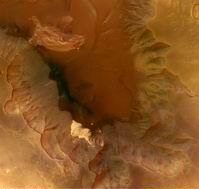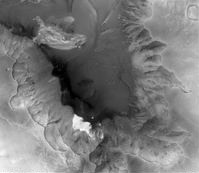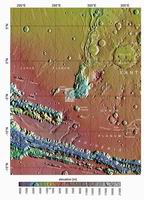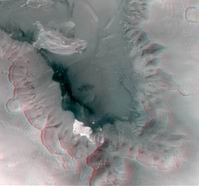Navigation/Menü: Links auf weitere Seiten dieser Website und Banner
19.01.2006
HRSC Press Release #053 - Juventae Chasma (orbit 0243)
 RGB Colour Image #1 |
Sulphate Deposits in Juventae Chasma
Am 26. März 2004 nahm die hochauflösende Stereokamera (HRSC) auf der ESA-Sonde Mars Express im Orbit 243 das Gebiet von Juventae Chasma mit einer Auflösung 23,4 Metern pro Bildpunkt auf. Die Abbildungen zeigen hiervon einen Ausschnitt bei 5° südlicher Breite und 297° östlicher Länge.
On 26 March 2004 the High-Resolution Stereo Camera (HRSC) onboard the ESA spacecraft Mars Express obtained image data in orbit 243 with a ground resolution of approximately 23.4 metres per pixel. The data were acquired in the region of Juventae Chasma, at approximately 5° southern latitude and 297° eastern longitude.
 Perspective view #1 |
 Perspective view #2 |
 Grayscale Nadir Image |
The colour scenes have been derived from the three HRSC-colour channels and the nadir channel. The perspective views have been calculated from the digital terrain model derived from the stereo channels. The anaglyph image was calculated from the nadir and one stereo channel. The black and white high resolution images were derived form the nadir channel which provides the highest detail of all channels.
 Context Map (MOLA) |
The High Resolution Stereo Camera (HRSC) experiment on the ESA Mars Express Mission is led by the
Principal Investigator (PI) Prof. Dr. Gerhard Neukum who also designed the camera technically. The
science team of the experiment consists of 40 Co-Investigators from 33 institutions and 10 nations.
The camera was developed at the German
Aerospace Center (DLR) under
the leadership of the PI G. Neukum and built in cooperation with industrial partners (EADS
Astrium, Lewicki Microelectronic GmbH and Jena-Optronik GmbH). The experiment on Mars Express
is operated by the DLR Institute of Planetary Research, through ESA/ESOC. The systematic
processing of the HRSC image data is carried out at DLR. The scenes shown here were created
by the PI-group at the Institute for Geological Sciences of the Freie Universitaet Berlin in
cooperation with the German Aerospace Center (DLR), Institute of Planetary Research, Berlin.

Red-cyan anaglyphe #1
Download
hochaufgelöste Bilddaten / full resolution image data
| Context Map (MOLA): | TIF (1.4 MBs) / JPG (622.2 KBs) |
| Grayscale Nadir Image: | TIF (14.5 MBs) / JPG (11.2 MBs) |
| RGB Colour Image #1: | TIF (42.6 MBs) / JPG (15.2 MBs) |
| Red-cyan anaglyphe #1: | TIF (30.7 MBs) / JPG (13.1 MBs) |
| Perspective view #1: | TIF (15.1 MBs) / JPG (5.9 MBs) |
| Perspective view #2: | TIF (11.5 MBs) / JPG (5.2 MBs) |
| Perspective view #3: | TIF (16 MBs) / JPG (6 MBs) |
| Perspective view #4: | TIF (19.4 MBs) / JPG (8.5 MBs) |

 Deutsch
Deutsch

